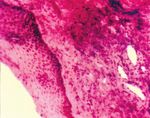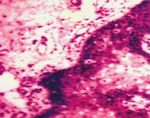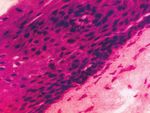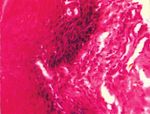Efficacy of hydrocortisone acetate/hyaluronidase vs triamcinolone acetonide/hyaluronidase in the treatment of oral submucous fibrosis
←
→
Page content transcription
If your browser does not render page correctly, please read the page content below
Indian J Med Res 131, May 2010, pp 665-669
Efficacy of hydrocortisone acetate/hyaluronidase vs triamcinolone
acetonide/hyaluronidase in the treatment of oral submucous fibrosis
Mangal Singh, H.S. Niranjan, Ravi Mehrotra*, Devashish Sharma** & S.C. Gupta
Departments of E.N.T. & Head & Neck Surgery, *Pathology &** Statistics & Demography, M.L.N. Medical
University College & S.R.N. Hospital, Allahabad, India
Received June 30, 2008
Background & objective: Oral submucous fibrosis is a common premalignant condition caused by
chewing arecanut and other irritants in various forms. Its medical treatment is not yet fully standardized,
although the optimal doses of its medical treatment is in the form of hydrocortisone acetate combined
with hyaluronidase. The problem with the prevailing treatment was injections at weekly interval. In this
study we compared the efficacy of hydrocortisone acetate and hyaluronidase at weekly interval versus
triamcinolone acetonide and hyaluronidase at 15 days interval.
Methods: Patients of OSMF (100) were randomly divided into two groups A and B. Group A patients
received combination of hydrocortisone acetate (1.5 ml)/hyaluronidase (1500 IU) at weekly interval
submucosally in pterygomandibular raphe, half dose on each side for 22 wk. Group B patients received
combination of triamcinolone acetonide (10 mg/ml)/ hyaluronidase (1500 IU) at 15 days interval for 22
wk. Treatment outcome was evaluated on the basis of improvement in symptom score, sign score and
histopathological improvement. Student’s ‘t’ test was applied for comparing the results.
Results: No statistically significant difference in symptom score, sign score and histopathological
improvement was seen between the two groups.
Interpretation & conclusion: Treatment regimen of group B was more convenient to the patients because
less number of visits required and cheap. No side effects were seen. A follow up study is required to see
long term effects.
Key words Hyaluronidase - hydrocortisone acetate - oral submucous fibrosis - tiamcinolone acetonide
Oral submucous fibrosis (OSMF) is a chronic confined to South East Asian countries especially in the
debilitating and a well recognized potentially malignant Indian subcontinent. Pathogenesis is not yet established
condition of oral cavity associated with arecanut but it is believed to be due to multifactorial causes. The
chewing characterized by generalized fibrosis of oral disease initially presents as burning sensation in oral
soft tissue resulting in marked rigidity and progressive cavity. It is clinically divided into three stages4. In stage
inability to open the mouth1-3. This disease is mainly 1 there is stomatitis, erythematous mucosa, vesicles,
665666 INDIAN J MED RES, may 2010
mucosal ulcers, melanotic mucosal pigmentation and oropharynx, partial or complete inability to protrude
mucosal petechiae. In stage 2, fibrosis occurs in ruptured out the tongue (ankyloglossia) with or without reduced
vesicles and ulcers when they heal. There is blanching mouth opening (trismus). After diagnosis staging
of oral mucosa. Vertical and circular palpable fibrotic was done according to the criteria of Pindborg 19894.
bands are seen in buccal mucosa. Specific findings Patients of stage II OSMF having trismus were included
include trismus, stiff and small tongue, blanched and in this study. Stage I and III were excluded. Trismus
leathery floor of mouth, fibrotic and depigmented was defined as mouth opening less than normal. Normal
gingiva, rubbery soft palate with decreased mobility, mouth opening was interincisor distance of 5.25 cm in
blanched and atrophic tonsils, shrunken band like males and 4.75 cm in females as measured by a caliper.
uvula and sinking of cheek not commensurate with age All patients were properly explained about the study
or nutritional status. In stage 3 there are sequelae in and their consent was taken. The study was cleared by
the form of leukoplakia in about 25 per cent of cases, Institutional Review Board.
speech and hearing deficits because of involvement of
tongue, palate and eustachian tubes5,6. The symptoms and signs were noted on a working
proforma. Scoring of symptoms like burning sensation
Most important aspect of medical treatment is in mouth upon consumption of spicy or hot foods and
cessation of habit of eating betel quid, arecanut, other local repeated vesicles or ulcer formation was done according
irritants, spicy and hot food, alcohol and smoking. The to verbal complaint rating scale of 0-10 points, where 0
most common mode of medical treatment had been the means no symptom and 10 means severe most symptom
use of steroids in its various forms7-11. Used other methods as perceived by the patient subjectively and signs were
include injection of placental extract12, use of trypsin, scored from 0 to 10 points according to a new criteria.
collagenase, hyaluronidase and elastase13 and intralesional Trismus was scored as 0 means no trismus where
Interferon-γ (IFN-γ)14. Oral zinc has been used15 as also oral interincisor distance was 5.25 cm or more in males
pentoxiphylline16 and lycopene with varying benefits17. and 4.75 cm or more in females, scored as 2 or grade I
Local injection of hyaluronidase mixed with where interincisor distance was more than 3 cm but less
hydrocortisone acetate had been used at our centre for the than normal, scored as 5 or grade III where interincisor
last 20 ys with satisfactory clinical results and without any distance was 2-3 cm and scored as 10 where interincisor
significant side effects. The problem with the treatment distance was less than 2 cm. Ankyloglossia was scored
was that the doses and duration of treatment had not been as 5 when protrusion of tongue was partial and scored
standardized. In a previous study, the treatment regimen 10 when there was inability to protrude out the tongue.
was standardized with patients of OSMF with trismus Vesicles or ulcers in oral cavity were scored 1 when
be treated by 1.5 ml (37.5 mg) hydrocortisone acetate there were unilateral single, scored 2 when bilateral
mixed with 1500 IU of hyaluronidase injection given single, scored 3 when unilateral multiple and scored 4
intralesionally half dose on each side at weekly interval when bilateral multiple. Areas of fibrosis were scored
for 22 wk18. The problem with prevailing treatment was 2 for each area – soft palate including uvula, right or
injection at weekly interval. So, this study was planned left anterior faucial pillar including tonsil, right or left
to see the efficacy of this treatment as compared to buccal mucosa including gingivobuccal sulcus, right or
triamcinolone acetonide (10 mg/ml) combined with left retromolar trigone, tongue or floor of mouth.
hyaluronidase (1500 IU) intralesionally once in 15 days The pretreatment histopathological examination of
for a total of 11 injections. the biopsy specimen from cheek mucosa was done in
Material & Methods each case and histopathological staging of OSMF was
done according to Pindborg and Sirsat criteria19.
This prospective randomized single blinded
outcome based study was done on 100 cases of All the four histopathological stages viz., very
clinically diagnosed oral submucous fibrosis done early, early, moderately advanced and advanced
during 2005-2006. Clinical diagnosis of OSMF was stage were given scores of 1, 2, 3 and 4 respectively.
based on symptom of burning sensation in mouth Patients were randomly divided into group A and B
upon consumption of spicy or hot foods, repeated according to a lottery system by keeping a mixture
vesiculation or ulceration in oral cavity and signs of 50 chits each of group ‘A’ and group ‘B’. Patients
observed were vesicles/ulcers in oral cavity, areas of were asked to pick up one chit and his treatment
fibrosis in vestibule of mouth, oral cavity proper and group was decided. Patients of group ‘A’ (n=50) wereSingh et al: EFFICACY OF HYDROCORTISONE ACETATE VS TRIAMCINOLONE ACETONIDE IN OSMF 667
treated by a combination of hydrocortisone acetate female ratio was 6.14:1. 71 per cent were in the habit of
(1.5 ml 25 mg/ml) and hyaluronidase (1500 IU) at using pan masala or dohra. Only 22 per cent used them
weekly interval for 22 wk and group ‘B’ were treated with betel quid and 7 per cent used betel quid only.
by a combination of triamcinolone acetonide, 10 mg/ Pre-treatment histopathological staging showed most
ml and hyaluronidase (1500 IU) at 15 days interval patients in moderately advanced stage (55%) followed
for 22 wk, i.e. 11 injections in 22 wk. Injection in all by early stage (43%) and advanced stage (2%).
patients were given submucosally in retromolar trigone
and adjacent soft palate and cheek, half dose on each All the patients who were registered were followed
side by one observer and response to treatment was up for 3 months after completion of treatment. There
assessed by another observer. The other clinician who were no dropouts. All the patients were aware of the fact
was observing response to treatment was not aware of that they are being treated for a pre-cancerous lesion.
the treatment group. After completion of treatment, There was no delay from diagnosis to commencement
repeat biopsy and histopathological examination was of therapy. But many patients although initially agreed
done to look for histopathological improvement. The for a post-treatment biopsy, refused biopsy after
histopathologist who was evaluating post-treatment completion of treatment.
biopsies was not aware of the treatment group. Table I shows pre-treatment and post-treatment
The response to treatment was assessed by noting symptom and sign scores, improvement in total (i.e.
subjective improvement in symptom score, objective symptom + sign) score and histopathological score in
improvement in sign score and histopathological score. group A and B. A comparison between both groups
Side effects of treatment both local as well as systemic did not provide any statistically significant difference
e.g., weight gain, blood pressure etc., were also noted. (P>0.05).
Period of post-treatment follow up was three months.
All the registered patients were followed up. Table II shows the details of change in
histopathological stage of OSMF in both treatment
Results
groups. Figs 1 and 2 show the photograph of
Patients of OSMF were between 14-65 yr old, histopathology slides of a patient from group ‘A’ which
a majority in their 30 (average 34 yr). The male to shows change in stage from moderately advanced to
Table I. Pre treatment and post-treatment symptom and sign score, improvement in total (i.e. symptom + sign) score and histopathological
score in group ‘A’ (n=50) and group B (n=50) (Data are mean ± SD)
Score
Group A Group B
Pre-treatment Post-treatment Reduction in score Pre-treatment Post-treatment Reduction in score
Symptoms
Burning sensation in 336.56 ± 27.16 42.48 ± 7.26 294.48 ± 15.76 328.18 ± 31.43 37.67 ± 9.11 291.04 ± 16.41
mouth upon
consumption of spicy
or hot foods
Repeated vesicle/ 147.33 ± 15.58 22.49 ± 5.67 124.89 ± 15.24 149.71 ± 12.69 19.88 ± 6.42 129.27 ± 14.72
formation
in oral mucosa
Sign
trismus 304.17 ± 19.58 133.33 ± 11.48 170.42 ± 16.27 292.59 ± 17.97 127.35 ± 13.67 165.89 ± 15.11
Ankyloglossia 205.54 ± 16.67 95.47 ± 8.59 110.72 ± 17.51 195.83 ± 19.13 90.28 ± 9.81 105.67 ± 16.76
Vesicles/Ulcers 46.26 ± 5.72 11.16 ± 2.76 35.61 ± 7.24 44.52 ± 5.78 10.57 ± 2.89 33.94 ± 8.41
Fibrosis 680.59 ± 47.86 360.43 ± 27.51 320.76 ± 54.76 688.59 ± 47.46 354.73 ± 29.21 333.86 ± 61.53
Total (Symtom+sign) 1707.42 ± 77.41 659.28 ± 49.87 1049.01 ± 97.14 1695.49 ± 81.57 633.48 ± 41.56 1036.01 ± 86.95
Score
Histopathological 39.05 ± 4.89 29.43 ± 3.78 9.67 ± 1.72 40.58 ± 5.06 30.55 ± 4.78 10.23 ± 2.05
score
Comparison between mean reduction of score between Group A and Group B shows no statistical significant difference between symptoms,
sign score, improvement in total (symptom + sign) score and histopathological score (P>0.05)668 INDIAN J MED RES, may 2010
Table II. Pre-treatment histopathological staging and post-treatment of properly designed trials and lack of standardized
histopathological staging of both group A (n=15) and group B (n=15) doses and duration of treatment we had standardized
Histopathological Group A Group B and recommended the treatment18. The problem with
staging Pre- Post- Pre- Post-
this treatment was injections at weekly interval.
treatment treatment treatment treatment Triamcinolone acetonide is a better corticosteroid for
Very early 0 2 0 2 intralesional injection as it has better local potency,
Early 6 12 5 11 longer duration of action and lesser systemic absorption.
Moderately 9 1 10 2 It was hypothesized that if it will be given at 15 days
advanced interval as in the treatment of keloid and hypertrophic
Advanced 0 0 0 0 scar, then it will be convenient to the patients. However,
there was not a single big study. Only case reports were
early stage and Figs 3 and 4 showed similar change in available10. We had followed a new scoring system in
group ‘B’. No local or systemic side effects were found which each symptom, sign and histopathological stage
in either treatment groups. of OSMF was given a particular score before and after
completion of therapy. Objectivity of the study was thus
Discussion
increased by observing improvement in symptom score
Despite much progress in understanding and by measuring pre and post-treatment interincisor
pathogenesis9,20 treatment of OSMF in the absence distance with a caliper and seeing histopathological
(1) (2)
(3) (4)
Figs 1-4. Photographs of histopathology slides of a patient from group ‘A’ (Figs 1 & 2) and group ‘B’ (Figs 3 & 4) which show change in
stage from moderately advanced to early stage.Singh et al: EFFICACY OF HYDROCORTISONE ACETATE VS TRIAMCINOLONE ACETONIDE IN OSMF 669
improvement. None of the previous studies had used 5. Khanna S. Histological changes in palatal and paratubal
this type of outcome measures. It is clear from our study muscles in oral submucous fibrosis. MS thesis, University of
Allahabad; 1999.
that there was statistically significant improvement in
symptom score, sign score, histopathological score in 6. Chaturvedi R. To study the Eustachian tube function in
patients of oral submucousfibrosis. MS thesis, University of
both groups after treatment and further there was no Allahabad; 2003.
statistically significant difference in outcome in both
7. Rao V, Raju PR. Treatment of SMF with cortisone. Indian
groups ‘A’ and ‘B’. There were no side effects in either J Otolaryngol 1954; 6 : 81-3.
group. Therefore, it is obvious that both treatment
8. Desa JV. Submucous fibrosis of the palate and cheek. Ann
regimens have similar outcome. Treatment regimen of Otol Rhinol Laryngol 1957; 66 : 1143-59.
group ‘B’ is more convenient to the patient’s because 9. George AT. Submucous fibrosis of the palate and buccal
it requires less number of visits to the consultants and, mucosa membrane. J. Indian Med Assoc 1958; 31: 489-90.
therefore, it is cheaper also. Hence it is recommended 10. Hamner JE 3rd, Looney DD, Chused TM. Submucous fibrosis.
that triamcinolone acetonide (10 mg/ml) combined Oral Surg Oral Med Oral Pathol 1974; 37 : 412-21.
with 1500 IU of hyaluronidase should be given 11. Kakar PK, Puri RK, Venkatachalam VP. Oral submucous
intralesionally particularly in retromolar trigone area fibrosis- treatment with hyalase. J Laryngol Otol 1985; 99 :
half dose each side at 15 days interval for a total of 57-9.
11 injections in 22 wk. This treatment regimen was 12. Ramanjarteyulu P, Prabhakar Rao BS. Submucous fibrosis-
better than IFN-γ because in the present study, mean new treatment. J Indian Dent Assoc 1980; 52 : 379-8.
improvement in trismus was 18 mm in group 'B' as 13. Sirsat SM, Khanolkar VR. Histological, electron microscope
compared to gain of 8±4mm with IFN-γ and there were and enzyme studies of submucous fibrosis of the palate.
no side effects as compared to IFN-γ14. J Pathol Bacteriol 1960; 79 : 53-8.
14. Haque MF, Meghji S, Nazir R, Harris M. Interferon gamma
In histopathological staging no patient was found (IFN -gamma) may reverse oral submucous fibrosis. J Oral
in early stage may be to the fact that we have included Pathol Med 2001; 30 : 12-21.
only stage II cases of OSMF2. Total improvement 15. Kumar A. Sharma SC, Sharma P, Chandra OM, Singhal
in histopathological score in group ‘A’ and ‘B’ was KC, Nagar A. Beneficial effect of oral zinc in the treatment
9.67+1.72 and 10.23+2.05 respectively. None of of oral submucous fibrosis. Indian J Pharmac 1991; 23 :
the earlier study looked at post treatment histo- 236-41.
pathological changes. Our study some shortcomings 16. Rajendran R, Rani V, Shaikh S. Pentoxifylline therapy: new
like long term effects after completion of therapy adjunct in the treatment of oral submucous fibrosis. Indian J
Dent Res 2006; 17: 190-8.
could not be done.
17. Kerr AR Efficacy of oral lycopene in the management of oral
References submucous fibrosis. Oral Surg Oral Med Oral Pathol Oral
Radiol Endod 2007; 103 : 214-5.
1. Cox SC, Walker DM. Oral submucous fibrosis. A review. Aust
Dent J 1996; 41 : 294-9. 18. Kinger A. To study the optimal dosage of hydrocortisone
acetate and hyaluronidase in the treatment of oral submucous
2. Aziz SR. Oral submucous fibrosis: an unusual disease. JNJ
fibrosis. MS thesis, University of Allahabad; 2004.
Dent Assoc 1997; 68 : 17-9.
19. Pindborg JJ, Sirsat SM. Oral submucous fibrosis. Oral Surg
3. Mathur A. Study of oral submucous fibrosis with special
Oral Med Oral Pathol 1966; 22 : 764-79.
reference of Pan masala. MS thesis. University of Allahabad;
1988. 20. Canniff JP, Harvey W, Harris M. Oral submucous fibrosis :
4. Pindborg JJ. Oral submucous fibrosis: a review. Ann Acad its pathogenesis and management. British Dent J 1986; 160
Med Surg 1989; 18 : 603-7. : 429-34.
Reprint requests: Dr Mangal Singh, Professor, Department of ENT & Head & Neck Surgery, M.L.N Medical University College &
S.R.N. Hospital, Allahabad 211 001, India
e-mail: drmangalsingh@rediffmail.comYou can also read





















































